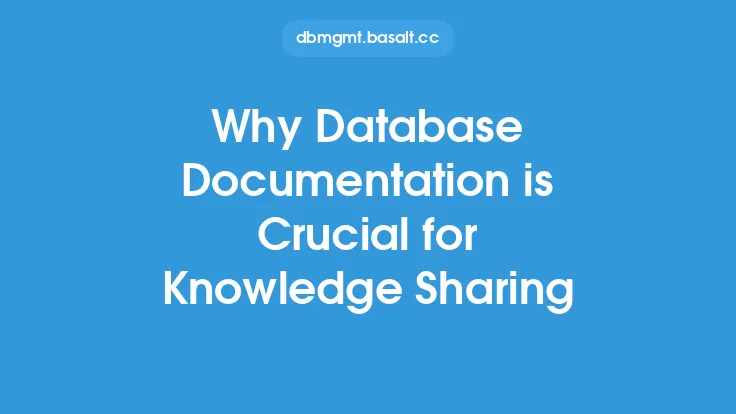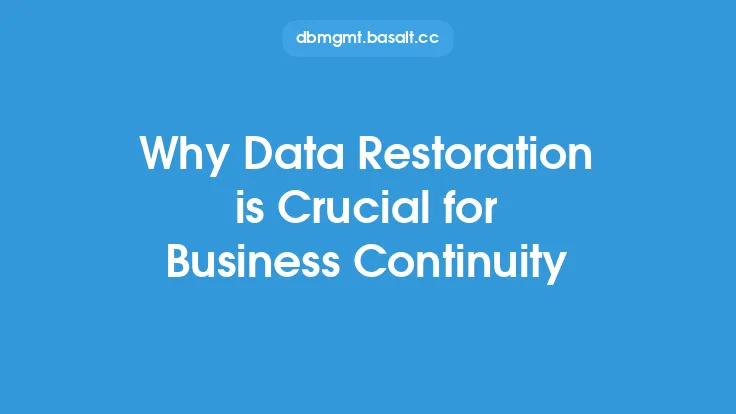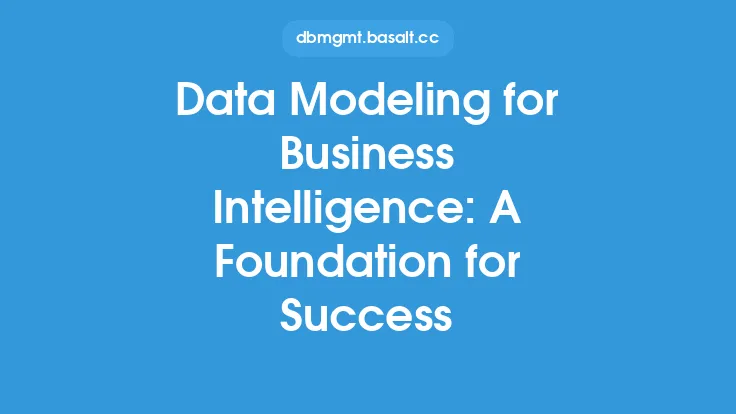In today's data-driven world, databases play a critical role in the success of businesses. They store, manage, and provide access to vast amounts of data, which is used to make informed decisions, drive business growth, and stay competitive. However, with the increasing reliance on databases comes the need for effective management and governance. Database governance is the process of managing and controlling the use of databases within an organization, ensuring that they are used in a way that is consistent with the organization's goals, policies, and procedures. It involves setting policies, procedures, and standards for the management of databases, as well as monitoring and enforcing compliance with these policies.
Introduction to Database Governance
Database governance is a critical aspect of database administration, as it helps to ensure that databases are used in a way that is secure, efficient, and effective. It involves a range of activities, including data modeling, database design, data security, and data quality management. Effective database governance helps to ensure that databases are aligned with the organization's overall strategy and goals, and that they are used in a way that supports business success. It also helps to reduce the risk of data breaches, data loss, and other security threats, and ensures that databases are compliant with relevant laws and regulations.
Benefits of Database Governance
There are many benefits to implementing effective database governance, including improved data security, increased efficiency, and better decision-making. With database governance, organizations can ensure that their databases are secure and that sensitive data is protected from unauthorized access. This helps to reduce the risk of data breaches and other security threats, and ensures that databases are compliant with relevant laws and regulations. Database governance also helps to improve the efficiency of databases, by ensuring that they are properly designed, implemented, and managed. This can help to reduce costs, improve performance, and increase productivity.
Key Components of Database Governance
Effective database governance involves a range of key components, including data modeling, database design, data security, and data quality management. Data modeling involves creating a conceptual representation of the data that will be stored in the database, and is used to define the structure and relationships of the data. Database design involves creating the physical structure of the database, including the tables, indexes, and other database objects. Data security involves protecting the database from unauthorized access, and ensuring that sensitive data is encrypted and protected. Data quality management involves ensuring that the data in the database is accurate, complete, and consistent, and that it meets the needs of the organization.
Database Governance and Compliance
Database governance is also critical for ensuring compliance with relevant laws and regulations. Organizations must comply with a range of laws and regulations, including data protection laws, privacy laws, and industry-specific regulations. Effective database governance helps to ensure that databases are compliant with these laws and regulations, by implementing policies, procedures, and standards for the management of databases. This includes ensuring that databases are properly designed, implemented, and managed, and that sensitive data is protected from unauthorized access.
Technical Aspects of Database Governance
From a technical perspective, database governance involves a range of activities, including database performance monitoring, database security auditing, and database backup and recovery. Database performance monitoring involves monitoring the performance of the database, including the response time, throughput, and other performance metrics. Database security auditing involves auditing the database for security vulnerabilities, and ensuring that sensitive data is protected from unauthorized access. Database backup and recovery involves creating backups of the database, and ensuring that the database can be recovered in the event of a failure or disaster.
Best Practices for Implementing Database Governance
There are several best practices for implementing effective database governance, including establishing clear policies and procedures, implementing a database governance framework, and providing training and education to database administrators and users. Establishing clear policies and procedures helps to ensure that databases are managed and controlled in a consistent and effective manner. Implementing a database governance framework provides a structured approach to database governance, and helps to ensure that all aspects of database management are considered. Providing training and education to database administrators and users helps to ensure that they have the skills and knowledge needed to manage and use databases effectively.
Challenges and Opportunities
Despite the importance of database governance, there are several challenges and opportunities that organizations must consider. One of the main challenges is the complexity of database governance, which can make it difficult to implement and manage effective database governance policies and procedures. Another challenge is the lack of resources and budget, which can make it difficult to implement and maintain effective database governance. However, there are also several opportunities, including the use of cloud-based database services, which can provide a cost-effective and scalable solution for database management. Additionally, the use of automation and artificial intelligence can help to simplify and streamline database governance, and provide real-time monitoring and alerts.
Conclusion
In conclusion, database governance is a critical aspect of database administration, and is essential for ensuring the security, efficiency, and effectiveness of databases. Effective database governance involves a range of activities, including data modeling, database design, data security, and data quality management. It also involves ensuring compliance with relevant laws and regulations, and implementing policies, procedures, and standards for the management of databases. By following best practices and considering the technical aspects of database governance, organizations can ensure that their databases are well-governed, and that they are used in a way that supports business success.





